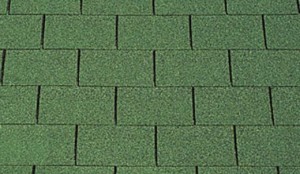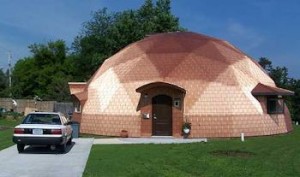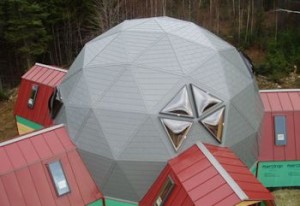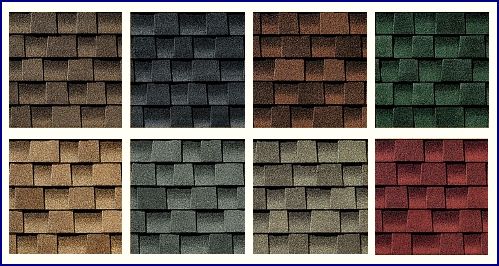Shingles and roofing geodesic domes
There a number of geodesic homes that are due for a new roof. If your dome home was built in the seventies, chances are very good this is the second time the roof has needed a makeover. For those building a new geodesic home, this is an opportunity to avoid the mistakes of past roofers who generally did not have the knowledge or skills to do the job.
The preferred solution these days is to use spray foam for both roofing and insulation, combining its insulating properties with the ability to make the home watertight. This last concern is often the most important one because there are many geodesic roofs that were not well done, which led to the belief that domes leak. This is absolutely false.
As you expect, using the best materials is the best solution. Roofing a dome is more demanding than a traditional home, and it pays off to go the extra mile for a long-lasting covering.
Do geodesic domes leak?
Domes don’t leak. Improperly roofed domes leak. There is nothing about a dome shape that causes leaks. If you have leaks in your building, there is a 99 percent chance it is caused by improper flashing at an opening in the roof, such as around a chimney, a vent pipe, a skylight, an extension where two different roof lines meet, or a dormer. Flashing these openings on a dome is no different that flashing these on a square house, and if they leak on your dome, they will leak on a square house if shingled and flashed the same.
Is elastomeric paint as an acceptable roof covering?
How many conventional square houses have you seen with elastomeric roofing? My guess is none. Elastomeric roofing has a long way to go before it is a proven waterproofing for a home, and I’m concerned there will be a backlash of condensation problems caused from trapping moisture in non-ventilated insulation spaces. The main reason elastomeric roofing seems an attractive option to people is because they hope it will be an easy and cheap roof. A proper elastomeric roof takes a 5 step application process, and a resurface is required every 10 years.
Specific challenges of a geodesic roof
Any roofer who worked on a geodesic roof job will tell you experience and skills need to be above average to be successful, and there is only a limited selection of materials that can be used.
The main obstacle is to address different slopes, angles and converging seams (hips); your contractor needs to be comfortable with complex operations because there are so many metal flashing parts to make manually.What this means for a potential client is to ensure the contractor has the specific skills required to roof a geodesic dome home.
The traditional methods and the alternatives
There are 2 basic ways to cover a dome: asphalt shingles or metallic shingles.
Then there is also an alternative for monolithic/concrete domes which normally do not use shingles.
Another solution which is gaining popularity is Spray Polyurethane Foam or SPF which we discuss further on.
Challenges and benefits of a metal roof
Any metal roof requires to cut and shape pieces, and this is even more true for geodesic roofs which comprise of many curved areas. This may also affect the metal chosen to work with. This will directly affect costs. Ideally a copper or zinc roof would be amazing but be very expensive. On the plus side, metal roofs last for many decades.
You may consider metal roofing as a safe alternative in areas with frequent lightning. Unlike asphalt or wood shake roofing which can catch on fire when lightning strikes, metal roofing disperses the lighting.
Regular or architectural shingles
Due to the angles of the geodesic dome it is common for rain to blow through roof shingles. This is one major reason to use quality shingles such as architectural types. Another consideration is shingles are water-shedding, not waterproof. This is why it is a waterproof underlayment is strongly recommended before installation of shingles.

3-tab shingles are the most common type used
Some will recommend using metal flashing to cover any seam, some see this as unnecessary. Windows on a dome also require a little more planning as their angle is rarely 90 degrees and may need to be custom-made to fit into the dome’s triangular shapes, not forgetting multiple pitches which may have your contractor charge more for the extra work.
There are a number of roofers that will recommend the dutch lap method, a shingle that is textured, overlayed, or laminated, designed to produce a three-dimensional effect similar to laminated shingle and architectural shingle.
Architectural shingles characteristics
Architectural shingles are considered high end. They are also referred to as three dimensional shingles or laminated shingles. They better resist breakage, insect damage and come in a wide choice of colors, styles, and warranties.
Architectural shingles often have a unique look as opposed to 3-tab shingles, having a cedar shake texture and appearance resulting in a significant and dramatic look to a dome or traditional home. Another benefit is their ability to mask imperfections. If that wasn’t enough they are also easier to install then 3-tab shingles. In short they are the best choice in roofing a geodesic dome with asphalt shingles.
Architectural shingles use a mat base, heavier than standard 3-tab shingles, typically weighing 100 to 200 lbs more per square (1 roofing square = 100 square feet). Their heavier weight and thickness make them less susceptible to curling and wind damage.
The base is made from organic or fiberglass materials coated with asphalt. Then the top layer has colored granules added to it. They are typically solid across their entire length as opposed to 3-tab shingles having a notched groove every foot. Multiple layers are then overlapped and laminated together for a three dimensional, textured appearance.
Architectural shingles come in many colors, textures and patterns. Some architectural shingles are designed to replicate the look of slate shingles or cedar wood shakes, but without the same high cost, heavy weight or susceptibility to insect damage.
Spray Foam Roofing
Some companies offer an alternative to traditional roofing materials: Spray Polyurethane Foam or SPF. Here are features listed by one major supplier, www.smartchoiceir.com:
Spray Foam Insulation |
Spray Foam Roofing |
Specialty Coatings |
| Reduces Energy use up to 50% | Provides Insulation | Repair spalling cement |
| Stops air and moisture infiltration | Seamless Monolithic | Skid-resistance surfaces |
| Increases building comfort | Eliminates Leaks | Many colors & textures |
| Adds strength to building structure | Reduces energy cost | Repair cracks & bridging |
| Keeps dust, mold and pollen out | No tear off, sustainable | Reduces maintenance cost |
| Reduces capacity requirementsand wear of HVAC equipment | Eliminates ponding | Chemically resistant coatings |
A common situation in covering a dome is the timing: many projects continue well into September and October when the days get colder and with more probability of morning humidity or rain. This is especially a factor when choosing spray polyurethane foam.
And this is in addition to getting access to the roof surface which often requires a scaffold and multiple ladders to effectively reach the target area. There usually are many situations where workers need to be secured from the top of the dome roof and swing around, meaning this is not a job for the average DIY type.






